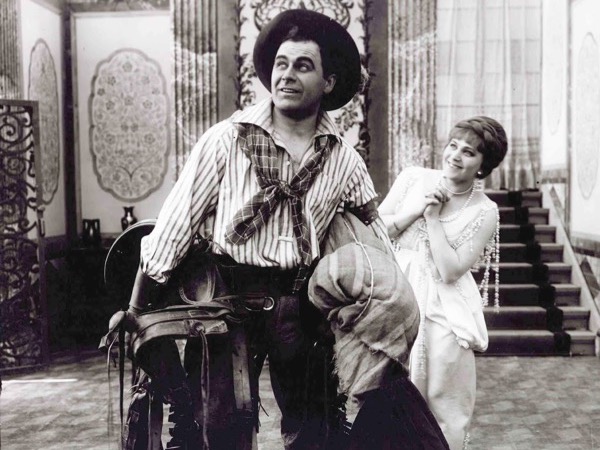MANDEN UDEN FREMTID
(The Man Without a Future)
Holger-Madsen (DK 1916)
Grace Fremont, a spunky American heiress, decides to vacation on the prairie with a few friends riding in several large caravans. Near Mac Winton’s ranch, she meets the dashing cowboy Percy Fancourt, and a romance blossoms. But soon, Grace’s millionaire father, warned by a footman, arrives to take Grace away. The despondent Percy receives a letter informing him that he is the last descendant of English aristocracy and heir to the title of Lord Langthorpe. Before leaving for Europe, he visits the Fremonts. Grace is delighted to see him, unpolished as he is, but rejects his proposal of marriage: he is a mere cowboy, a man without a future. After he has left, she reconsiders, sending him a letter in which she declares her love and begs his forgiveness. Visiting Europe, Grace makes the social rounds. When she is introduced to “Lord Langthorpe,” he pretends not to recognize her, and she is devastated. She does not know the letter has gone astray, and Percy has not read it…
This light-hearted film uses the Wild West as a setting for comedy and romance, not violence. Shot in the spring of 1915, the film takes the classic comic motif of the heroic commoner showing up the snooty aristocrats, but turning out to be high-born himself, and transplants it to the American West. Its fish-out-of-water comedy has some resemblance to Douglas Fairbanks’ western comedies – e.g., Wild and Woolly. The Man Without a Future appears to have had a U.S. release: it was copyrighted under that title on 2 January 1917, registered with 92 prints.
In his study of the film as a star vehicle (Kosmorama.org, issue #267), Stephan Michael Schröder describes how ace screenwriter Harriet Bloch (1881-1976) wrote the film specifically for its leading man, Valdemar Psilander (1884-1917), the biggest male star of the Danish silent cinema, keeping him on screen for more than three-quarters of the film’s total running time.
The impulse for the film apparently came from Psilander himself. His friend and colleague Robert Schmidt wrote years later that Psilander was “a romantic – full-blooded; in his coat pocket he often had a volume of Jack London or Frank Norris. He dreamed of California’s open spaces as a playground for his fancies.” According to a 1962 interview with Bloch, she asked Psilander what he would like to play in his next film, and he replied: “A cowboy.” Bloch obliged with a script that introduces the character as “a strong, beautiful Mr. Cowboy in a picturesque outfit with weather-beaten, sun-tanned skin and a natural character.”
The locations do not look very American, but a great deal of effort has clearly gone into the costuming: the film’s cowboys wear proper chaps and leather wrist cuffs, and they use authentic-looking saddles with saddle horns and hooded stirrups (tapaderos). The line dance we see performed is nothing if not spirited. The film is well lit and shot, cutting in to closer views with some frequency, and it features several splendid shots of Psilander on horseback taken from a moving car. Psilander and Wieth first appeared together in Ved Fængslets Port/Temptations of the Big City (August Blom, 1911), a breakthrough film for both, and Wieth’s charm and playfulness provide the right complement for Psilander’s romantic manliness.
The year 2017 is the centenary of the early death of Psilander, and this film showcases his talent. He takes to the role of the hale and hearty cowboy turned aristocrat with evident relish, looking equally at ease in the saddle and in white tie and tails. Robert Schmidt wrote: “I have never seen him more beautiful or more in his place, and never more himself than when he was in the cowboy outfit.”
Casper Tybjerg

scen: Harriet Bloch.
photog: Marius Clausen.
cast: Valdemar Psilander (Percy Fancourt), Oscar Stribolt (Hugh Fremont), Clara Wieth (Grace, sua figlia/Fremont’s daughter), Philip Bech (Mac Winton), Augusta Blad (la duchessa/Duchess of Westaby), Torben Meyer.
prod: Nordisk.
uscita/rel: 28.08.1916.
copia/copy: 35mm, 1002 m., 53′ (18 fps); did./titles: DAN, ENG.
fonte/source: Danske Filminstitut, København.


 Italiano
Italiano